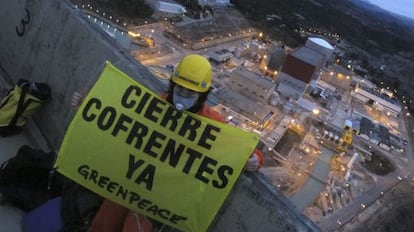Greenpeace faces “toughest trial” yet in Spain over nuclear plant protest
Prosecutor seeking two-and-a-half-year jail terms for 16 activists and a photographer

After three decades of environmental activism in Spain, Greenpeace has got used to its protest actions ending in court sanctions.
Right now, the group has 19 proceedings open against it in the country, in which it is facing around €623,000 in fines. “Our actions normally finish with a punishment for disorder, which we end up paying,” says Greenpeace’s director in Spain, Mario Rodríguez.
But the case involving the group’s actions at the Cofrentes nuclear power plant in Valencia is different: not only because of the size of the fine the group is facing – €357,371 – but also because those involved could also be sentenced to prison. The public prosecutor has called for 16 Greenpeace activists and prize-winning photojournalist Pedro Armestre to be jailed for two years and eight months for entering the plant, painting graffiti and placing a placard in the early hours of February 15, 2011.
Their actions resulted in a struggle with Cofrentes security guards, say prosecutors
The hearing begins on Thursday in Valencia and will last a week. The 17 are accused of public disorder and causing injury and damage. Greenpeace calls it is the “toughest trial” is has yet faced in Spain.
The prosecution says the accused planned “to destabilize the organization of the plant.” It holds that “dressed in orange overalls bearing the inscription Greenpeace, they accessed the interior of the security perimeter,” cutting “three security access perimeter fence, making use of a circular saw and other tools they were carrying.”
Their actions resulted in the activation of the plant’s emergency plan and a struggle with Cofrentes security guards, who received blows, the prosecution maintains. It also says that “one of the group, after turning round with the saw in motion, cut the abdominal area of one of the guards,” who was slightly injured. Once inside, three activists climbed the plant’s cooling towers, painted graffiti and placed a placard.
Once inside, activists climbed the plant’s cooling towers and painted graffiti and placed a placard
The prosecutor says that civil guards who later attended the scene urged the activists on “repeated occasions” to change their attitude, but were ignored.
Greenpeace defines itself as a peaceful organization and says it did not resort to violence at Cofrentes, a claim that plant owner Iberdrola rejects. Mario Rodríguez believes the case is aiming to criminalize “peaceful protest” and that the punishments sought “are excessive and disproportionate.”
Photojournalist Pedro Armestre, an Ortega y Gasset Prize winner who covered the Cofrentes protest, describes something similar: “There was tension, but no violence or blows,” he says.
According to Rodríguez, the biggest punishment Greenpeace has had to face in Spain to date occurred in 2005 when a Cádiz judge convicted the captain of the organization’s Rainbow Warrior ship over a protest against the Iraq War. He was sentenced to six months in prison for disobedience, while another activist received a 10-day jail term.
Tu suscripción se está usando en otro dispositivo
¿Quieres añadir otro usuario a tu suscripción?
Si continúas leyendo en este dispositivo, no se podrá leer en el otro.
FlechaTu suscripción se está usando en otro dispositivo y solo puedes acceder a EL PAÍS desde un dispositivo a la vez.
Si quieres compartir tu cuenta, cambia tu suscripción a la modalidad Premium, así podrás añadir otro usuario. Cada uno accederá con su propia cuenta de email, lo que os permitirá personalizar vuestra experiencia en EL PAÍS.
¿Tienes una suscripción de empresa? Accede aquí para contratar más cuentas.
En el caso de no saber quién está usando tu cuenta, te recomendamos cambiar tu contraseña aquí.
Si decides continuar compartiendo tu cuenta, este mensaje se mostrará en tu dispositivo y en el de la otra persona que está usando tu cuenta de forma indefinida, afectando a tu experiencia de lectura. Puedes consultar aquí los términos y condiciones de la suscripción digital.
More information
Greenpeace activists injured after navy blocks Canaries oil drilling protest
Últimas noticias
From digital curfews to blocking apps: How technology experts protect their children online
Why the price of coffee has skyrocketed: from Brazilian plantations to specialty coffee houses
Confined to a Cuban hospital: When electricity is a matter of life or death
The complicated life of Francesca Albanese: A rising figure in Italy but barred from every bank by Trump’s sanctions
Most viewed
- Why we lost the habit of sleeping in two segments and how that changed our sense of time
- Pablo Escobar’s hippos: A serious environmental problem, 40 years on
- Trump’s obsession with putting his name on everything is unprecedented in the United States
- The Florida Keys tourist paradise is besieged by immigration agents: ‘We’ve never seen anything like this’
- Charles Dubouloz, mountaineering star, retires at 36 with a farewell tour inspired by Walter Bonatti








































